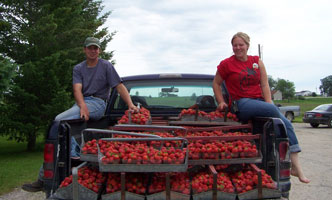9/25/2013
The Berries Bring Them In
Pam Buddy-D’Ambrosio

When A.J. MacArthur was a young boy and heard a tractor running, he had to be on it. His tractor fascination led to a gardening interest, and as a teen, A.J. planted strawberries, raspberries and veggies in his grandmother’s yard. He brought items to farmers markets, but stopped going due to too much competition. After four or five years, he began growing for the fruit market in Alpena, Michigan, and with a main highway running near the farm, he put up a sign and started selling berries to passersby.
Today, in Lachine, part of Alpena County in the northeastern portion of the lower peninsula, A.J. and his wife Amy are co-owners of A.J.’s Garden and Produce, Inc. Near the shores of Lake Huron, A.J. and Amy have six acres of raspberries, 11 acres of strawberries and two acres of saskatoons (or June berries). Native to Canada, the berries are similar in look to blueberries and are ready at about the same time as raspberries.
The farm is made up of additional acres of wheat, rye, buckwheat, oilseed radishes, soybeans and vegetables such as red beets, sweet corn, asparagus, squash and pumpkins. Among all of the crops, the U-Pick fruit makes up two-thirds of the business. The remaining one-third is divided between direct sale and wholesale—five farmers markets within a two-hour drive.
The traffic in the area picks up when tourists visit the lakes.
“They buy produce for their week at the lake or on the way home they pick up fruit for their freezers,” says A.J. If they want to pick the fruit themselves, there are rules they must follow, but people have their peccadilloes or “pick-adilloes.” A.J. designates the row to pick. Some pickers say their rows don’t have good berries.
“Then you see where they were and it looks like they didn’t pick—they want only one size and one color,” says A.J. Some customers are not clean pickers; therefore, A.J. or other employees must follow them to clean the fruit off of the plants.
A.J. and the employees don’t miss a berry. “If you miss one picking, then you’re done because when the fruit is rotten, the bad spreads to the good. I know where the best stuff is. I want to give people the best,” he says.
The customers are made up folks of every age, young kids to seniors, although, “the seniors come to the store for the already-picked,” says A.J. “I’ve seen an increase of younger families in the last three to four years.”
It’s fortunate because the farm is located in an area filled with retirees. “They don’t eat as much, although, they don’t quibble about pricing,” says A.J. It’s good for the retirees that there’s direct sale since it reduces the side effects of picking—sore backs and knees.
The wholesale customers pick up the fruit at the farm.
“One guy came pretty steady and he picked 100 to 1,000 quarts every time. He came with 13 people who picked 100 to 130 flats a day,” explains A.J. “We try to keep something going as much as we can. In November, after pumpkin season, we start the Christmas wreaths. We make 4,000 door-size wreaths and direct market them by going go door-to-door in Alpena; other wreaths are sold wholesale in Detroit.”
Amy keeps the store, which is an 800-sq. ft. retail area. The produce is sold together with frozen fruit, dried fruit and maple syrup. The family members have restored an 1888 barn and in 2008 opened the store. A.J.’s brothers and father are available when needed to build or repair machines. A.J. gives his mom the “fastest picker” moniker.
And A.J. can’t forget his grandma. It was at her house that he had his first garden. She would hoe and pick and now she takes care of A.J.’s and Amy’s three daughters. To help the family, there’s one full-time person and between three to 15 part-time people during the peak season.
“The family is supportive,” says A.J. “But cautioned me about farming, saying there was no future in crop farming, but I didn’t dive in … I was cautious.
“I had no official schooling for farming. I read six trade magazines and am well versed in what’s coming. I go to educational classes at MSU and [growing associations’] tours and seminars. When I graduated and did the one acre of berries, it was a good test that if God wanted us to do this we’d have a good year. We had an absolutely fabulous year of strawberries. He’s blessed us ever since,” says A.J.
Tips from A.J.:
- “Very seldom do we buy new. Only one tractor and one irrigation pump were purchased new (we can’t afford to break down with the frost).”
- “Start slowly with experimental crops, for instance, the two acres of saskatoons. Grow single rows and watch what attacks them. I’m a plodder. I’m not in a hurry to get anywhere.”
- “Try to do almost everything yourself. It helps that members of our family are good with mechanics. We do it ourselves when we can.”
- “Try not to grow things that take time and don’t give a good return. We used to grow red potatoes—it took too much time and didn’t make money.” GT
Pam Buddy-D’Ambrosio is a freelance writer in New Rochelle, New York.